Bavaria - Straubing fair
| bottom |
Homepage Feedback? Enter your comments in the guest book |
Paris | |
| Previous | Back to Travelogue | Next |
4 of 15 |
|
Click on any picture to bring up the picture enlarged in a new window |
|||
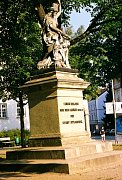 Frieda and Agnes decided to take us to the Straubing fair. As far as I could
tell it's like a state fair in America. MN state fair
We found a spot to park in a parking ramp and walked from there through village to the fair.
Here is a statue of ?
Straubing is on the Danube river and
is the agricultural center of Lower Bavaria. It is also an industrial center. It manufactures machinery,
electronics, and beer. Originally a Roman camp, Straubing later became (1353) the capital of the
duchy of Bavaria-Straubing, which was ruled by a branch of the Wittelsbach family.
Frieda and Agnes decided to take us to the Straubing fair. As far as I could
tell it's like a state fair in America. MN state fair
We found a spot to park in a parking ramp and walked from there through village to the fair.
Here is a statue of ?
Straubing is on the Danube river and
is the agricultural center of Lower Bavaria. It is also an industrial center. It manufactures machinery,
electronics, and beer. Originally a Roman camp, Straubing later became (1353) the capital of the
duchy of Bavaria-Straubing, which was ruled by a branch of the Wittelsbach family.
|
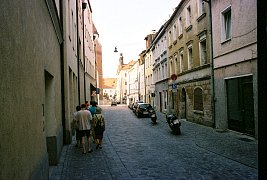
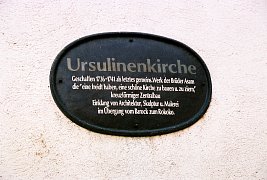 The streets were narrow as we walked along. Yes,
that's cobblestone. In
the picture on the left you can see up ahead the
Ursulinenkirche, or Church of the Ursulinen.
We stopped in and
listened to chanting nuns.
The Ursulinen is the school where Frieda went for nine years at
Gymnasium. She was taught by the nuns, besides other subjects, English, Latin and
French.
The church is very famous - built by the family Asam (father and
sons, the most
famous were Cosmas and Damian Asam, architects, sculpterers and
painters). It was built 1736 thru 1741 as last common work of the Asam brothers.
The building is cross shaped, with a harmony of
architecture, sculpture and painting. It is of a transition style
from Bavarian baroc to roccoco.
The streets were narrow as we walked along. Yes,
that's cobblestone. In
the picture on the left you can see up ahead the
Ursulinenkirche, or Church of the Ursulinen.
We stopped in and
listened to chanting nuns.
The Ursulinen is the school where Frieda went for nine years at
Gymnasium. She was taught by the nuns, besides other subjects, English, Latin and
French.
The church is very famous - built by the family Asam (father and
sons, the most
famous were Cosmas and Damian Asam, architects, sculpterers and
painters). It was built 1736 thru 1741 as last common work of the Asam brothers.
The building is cross shaped, with a harmony of
architecture, sculpture and painting. It is of a transition style
from Bavarian baroc to roccoco.
|
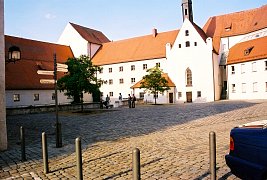 Here is the courtyard Burggasse where Agnes Bernauer was tried and found guilty.
Agnes Bernauer - "The Angel of Augsburg"
About this sad story the poet F. Hebbel wrote a drama in 1855.
In Straubing every 4 or 6 (?) years amateurs play this
piece.
Here is the courtyard Burggasse where Agnes Bernauer was tried and found guilty.
Agnes Bernauer - "The Angel of Augsburg"
About this sad story the poet F. Hebbel wrote a drama in 1855.
In Straubing every 4 or 6 (?) years amateurs play this
piece.
|
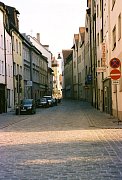
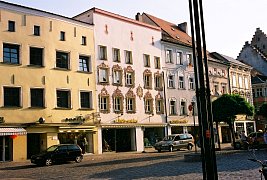 The building style in Straubing is very distinctive. I liked the ornate
windows on this building (near right). We are now on a very wide main
street of Straubing.
The building style in Straubing is very distinctive. I liked the ornate
windows on this building (near right). We are now on a very wide main
street of Straubing.
|
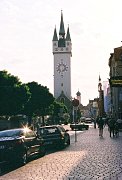
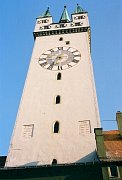 The clock tower in Straubing - it's symbol and emblem.
In former times they used it as watch-tower against enemies, but its most important
use was to discover fire in the city as early as possible, because most of the
buildings were wooden, and the whole city could be burned down.
The watchman had a bell he rang in the event of fire.
Additionally the guardian announced every hour the time. The tower is 68
meter high and is was built in the 14th century.
My camera malfunctioned here, and I had
to sit and fix it. Many, many primarily young adults passed us, many
dressed up in traditional Bavarian dress. This fair was a big deal.
The clock tower in Straubing - it's symbol and emblem.
In former times they used it as watch-tower against enemies, but its most important
use was to discover fire in the city as early as possible, because most of the
buildings were wooden, and the whole city could be burned down.
The watchman had a bell he rang in the event of fire.
Additionally the guardian announced every hour the time. The tower is 68
meter high and is was built in the 14th century.
My camera malfunctioned here, and I had
to sit and fix it. Many, many primarily young adults passed us, many
dressed up in traditional Bavarian dress. This fair was a big deal.
|
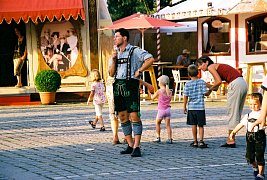 The streets were full of people hurrying to the fair. Quite a few
men and women wore traditional German outfits. We window shopped at a
clothing store and I remember that one men's outfit cost 200 euros -
currently about $225 American. Lots of outfits are made from leather.
Note in this picture that besides the gentlemen in the center a small
boy at the right is also dressed traditionally.
The gentleman wears Lederhose (leather trousers),
Wadenstrümpfe (calf high socks), and Haferlschuhe (special shoes).
The streets were full of people hurrying to the fair. Quite a few
men and women wore traditional German outfits. We window shopped at a
clothing store and I remember that one men's outfit cost 200 euros -
currently about $225 American. Lots of outfits are made from leather.
Note in this picture that besides the gentlemen in the center a small
boy at the right is also dressed traditionally.
The gentleman wears Lederhose (leather trousers),
Wadenstrümpfe (calf high socks), and Haferlschuhe (special shoes).
|
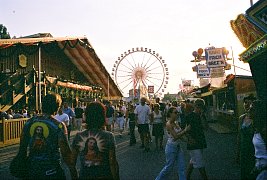
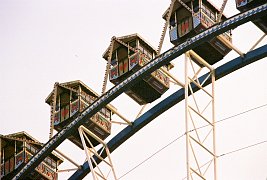 Giant Ferris wheel with gingerbread houses for seats.
Giant Ferris wheel with gingerbread houses for seats.
|
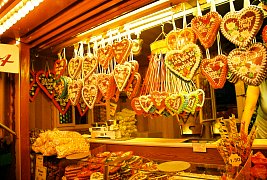 These giant cookies are not edible. They are rock hard and their purpose is
sentimental. You buy one that says "I love you", for instance, for your
sweetheart.
These giant cookies are not edible. They are rock hard and their purpose is
sentimental. You buy one that says "I love you", for instance, for your
sweetheart.
|
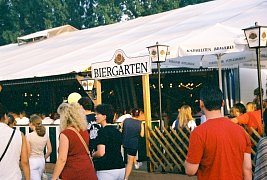 We are in Germany - here is a beer garden.
We are in Germany - here is a beer garden.
|
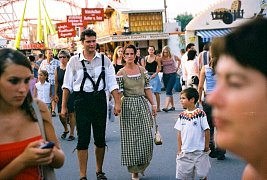
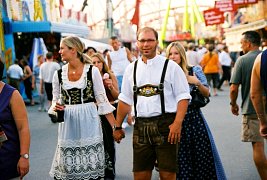 Here are some more native outfits. It seemed to be by couple.
Here are some more native outfits. It seemed to be by couple.
|
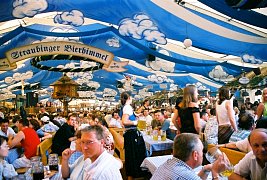
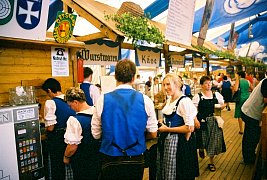
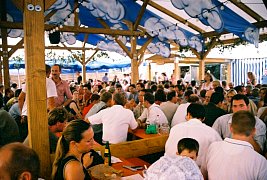 Here is the beer garden we stopped at. I wanted to make sure I took
a picture of some of the servers. I just like to look over the crowd in
these pictures. You have to be pretty strong to carry multiple beers.
Here is the beer garden we stopped at. I wanted to make sure I took
a picture of some of the servers. I just like to look over the crowd in
these pictures. You have to be pretty strong to carry multiple beers.
|
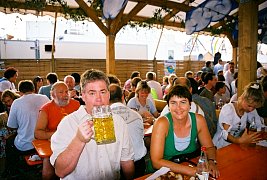 Here is Frieda and me and my big beer.
Here is Frieda and me and my big beer.
|
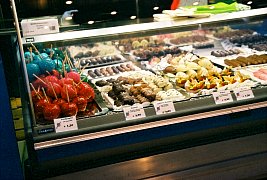 Here for sale is a case filled with various candies.
Here for sale is a case filled with various candies.
|
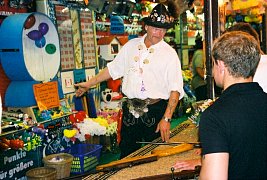 Frieda had explained to us about men who wear coins on their shirts and around
their belts. They are trying to send a message that they are rich farmers.
Frieda had explained to us about men who wear coins on their shirts and around
their belts. They are trying to send a message that they are rich farmers.
|
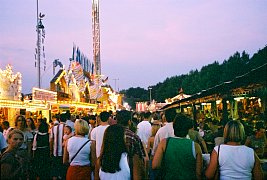 It's near dusk, the festive lights have come on, and we are making our way
through the crowd. Right ahead of me are Margaret, Frieda, and Agnes.
It's near dusk, the festive lights have come on, and we are making our way
through the crowd. Right ahead of me are Margaret, Frieda, and Agnes.
|
| top |
Homepage Feedback? Enter your comments in the guest book |
Paris | |
| Previous | Back to Travelogue | Next |
4 of 15 |
|
Click on any picture to bring up the picture enlarged in a new window |
|||